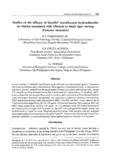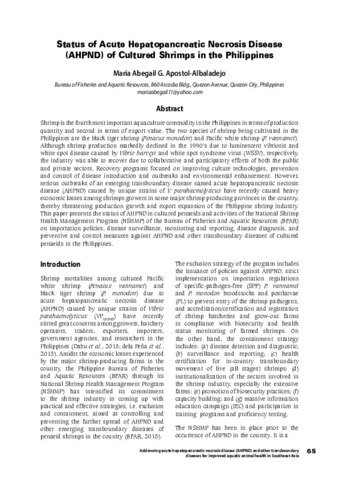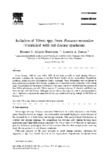Studies on the efficacy of Sarafin® (sarafloxacin hydrochloride) on vibrios associated with vibriosis in black tiger shrimp (Penaeus monodon)
Share
Abstract
In vitro activity of Sarafin® (sarafloxacin hydrochloride) was determined against 7 luminous Vibrio harveyi isolates and 3 non-luminous Vibrio species (V. parahaemolyticus, V. alginolyticus and Vibrio species) isolated from diseased shrimp (Penaeus monodon) and rearing water, a strain of V. anguillarum from diseased marine fish, 1 strain each of V. alginolyticus, V. vulnificus, and V. mimicus from diseased grouper (Epinephelus coioides), and V. alginolyticus from diseased seabass (Lates calcarifer). Bacterial susceptibility was expressed as minimum inhibitory concentration (MIC) and minimum bactericidal concentration (MBC). The MIC and MBC values obtained for all V. harveyi isolates ranged from <0.3 to 1.25 µg/ml. For the non-luminous Vibrio species, MIC and MBC values ranged from <0.08 to 1.25 µg/ml. In vivo tolerance levels (24 h static bioassay) of larval and postlarval stages of P. monodon for Sarafin® were <10 µg/ml for nauplii, mysis, and postlarvae and ≤1 µg/ml for zoeae. Morphological deformities in the carapace, rostrum, and setae were noted among larvae exposed to >50 µg/ml Sarafin®. These results indicate that Sarafin® is a potential candidate as a chemotherapeutic agent against luminous vibriosis in P. monodon.
Suggested Citation
Pakingking, R. V., Jr., Cruz-Lacierda, E. R., & Torres, J. L. (2002). Studies on the efficacy of Sarafin® (sarafloxacin hydrochloride) on vibrios associated with vibriosis in black tiger shrimp (Penaeus monodon). In C. R. Lavilla-Pitogo & E. R. Cruz-Lacierda (Eds.), Diseases in Asian aquaculture IV: Proceedings of the Fourth Symposium on Diseases in Asian Aquaculture, 22-26 November 1999, Cebu City, Philippines (pp. 125-134). Fish Health Section, Asian Fisheries Society.
Subject
Taxonomic term
Collections
Related items
Showing items related by title, author, creator and subject.
-
Current status of shrimp farming and diseases in Cambodia
Lang, Ouch; Sothea, Mey (Aquaculture Department, Southeast Asian Fisheries Development Center, 2016)The farming of penaeid shrimps in Cambodia began in 1989 and has significantly expanded since 1991. Shrimp cultivation has been carried out in the four coastal provinces, i.e. Kampot, Kep, Preah Sihanouk Ville, and Koh ... -
Status of acute hepatopancreatic necrosis disease (AHPND) of cultured shrimps in the Philippines
Apostol-Albaladejo, Maria Abegail G. (Aquaculture Department, Southeast Asian Fisheries Development Center, 2016)Shrimp is the fourth most important aquaculture commodity in the Philippines in terms of production quantity and second in terms of export value. The two species of shrimp being cultivated in the Philippines are the black ... -
Isolation of Vibrio spp. from Penaeus monodon (Fabricius) with red disease syndrome
Tendencia, Eleonor; Dureza, Lourdes A. (Elsevier, 1997)From January 1990 to June 1993, 59% of the total juvenile to adult shrimp Penaeus monodon submitted for diagnosis at the Fish Health Section of the Aquaculture Department, Southeast Asian Fisheries Development Center, ...






